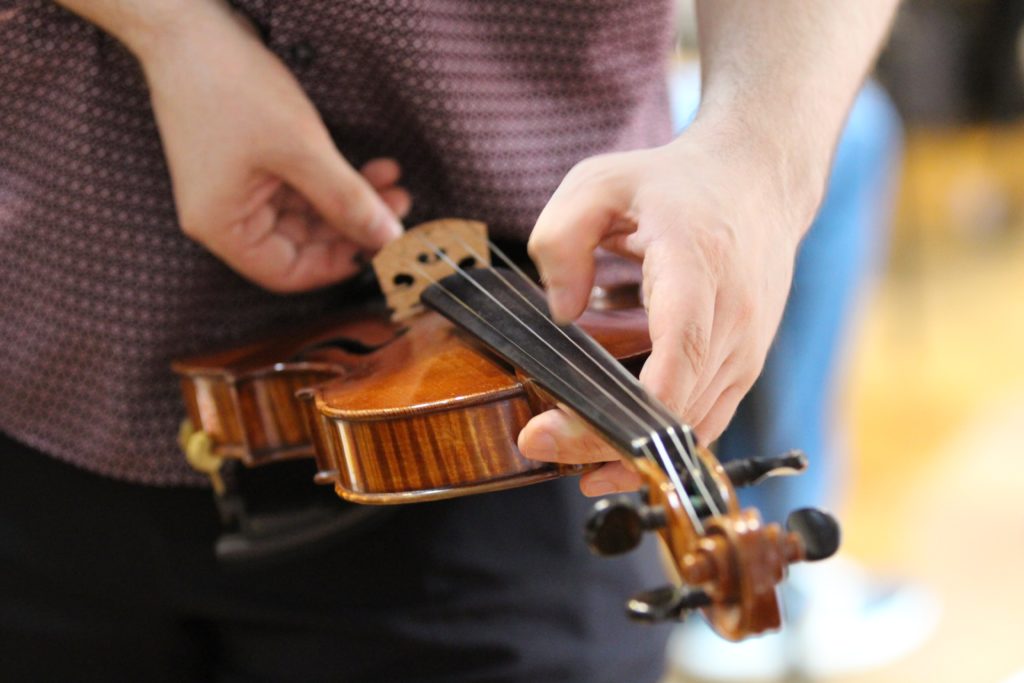If you're about to embark upon a Violin Course, a series of violin lessons, a new school term, or even just a new routine of regular practice, then it makes sense to get your instrument into the best possible condition before you start!
There are few things more frustrating (and demotivating!) than diving into a new period of learning with excitement and enthusiasm, only to find that you can't make progress because your tools are faulty, worn or out of date! So follow this checklist before you go to your first class or practice session!

Check the Strings
Violin Strings wear out. If you've been playing a lot, you'll find that they may have become worn, dull in sound, or even started to lose their outer coating (in which case they'll need replacing immediately - before they hurt your fingers, or weaken and snap!)
Or if you've not been playing at all, and the violin has been sitting unplayed in a cupboard for a while (it happens!), then the strings may have deteriorated through lack of use. Either way, one of the smartest things you can do before starting a new course is to check (and if necessary replace) the strings.
For regular players, it makes sense to buy a new set of strings every year or two, but if you play a lot, you may want to do this more regularly. Some professional players will replace the strings before every major concert tour, but it quickly becomes an expensive habit if you do this every couple of months!
On the other hand, you don't want to leave it years between each string change. Even if you don't notice the strings wearing out because it's so gradual, you'll definitely hear the difference once a new set is on the violin... it breathes new life into an instrument!
Spare Strings
It's remarkable how many people, especially at beginner level, don't have a spare set of strings. Strings do sometimes break - this is normal! But if you're nowhere near a violin shop, or need to wait for an online order to arrive, you may find yourself unable to practise for several days...
...don't risk it! Get a spare set of strings and you'll be prepared for when string disaster strikes!
'Playing In' New Strings
If you replace your violin strings the day before your first class, then you should expect to have minor difficulties tuning the violin for at least a couple of days. This is because new strings need to be 'played in'... they need to get used to the tension that's created by winding and fixing them onto the violin.
The strings will naturally stretch during this process, which musicians sometimes refer to as 'settling' ("I just changed my strings; they need some time to settle"). Until newly attached strings are stable, you may find that they violin slips out of tune far more than usual!
The amount of time it takes for violin strings to settle does depend on the make and model of the string, and on the thickness (generally, the lower strings will take longer to settle than the higher strings, though this can vary). As a general rule, a few hours of playing over a couple of days is usually enough to 'play in' strings to the point at which they become stable.
Keep a set of old strings!
It's good practise to have used strings on hand in case you have a string break during a concert, and need an urgent replacement that's already been 'played in'. After all, if a string has already been stretched and worn, it's not going to slip out of tune as easily as a brand new string that hasn't been used.
So keep your most recent set of old strings in your violin case... just in case you have a string snap just before - or even during! - a concert or event. You'll be glad you did!
Check the Bow Hair
Another 'perishable' part of your equipment is the bow hair. Over time, the bow hair - like the strings - becomes worn and less responsive. Bow hair can also become dirty (especially near the heel, if you're in a habit of making contact between the bow hair and your right thumb.
So you should consider refreshing it on a regular basis (but be aware that, if you're using a cheap bow, it may not make economic sense... bow rehairs are usually more expensive than replacing cheap bows).
It's also common for the hairs of the bow to break from time to time (especially if you're playing a lot of ferocious, fast music... or if you're pressing too hard on the string!).
So even if your bow hair is fairly new, make sure that you've got a full complement of bow hairs on the bow, and that it's not becoming too one-sided (as hairs will tend to break on the far side of the bow - i.e. away from you - due to how we tilt the bow when playing).
If you play a lot, then you might find yourself needing to replace the bow hair more than once per year. But for many people, it's something that only needs to be done every couple of years.
Accessories
Is your rosin in good condition? Is your music stand working well? Do you have enough pencils and pencil sharpeners? Do you need to replace the soft cloth that you use for wiping down your violin after using it?
It's easy to get into bad habits and forget how important these tiny details are. Having a 'duster' or microfibre cloth (for wiping rosin off the instrument's surface when you put it way) is a good example... there are plenty of violinists who keep the same cloth for so long, and don't think of ever washing or replacing it!
Music stands, especially cheap collapsable ones, can break easily. And though it might seem like a secondary detail, a faulty music stand can be enough to significantly disrupt a violinist's practice routine! Make sure that you have all these little things taken care of, and you'll have fewer obstacles in the way of achieving your learning goals.
Here's a comprehensive list of things to check before embarking on the next stage of your learning. Can you think of anything we've forgotten? If so, let us know at [email protected]!
The Violin
The Bow
Accessories
Please visit our sponsors:
London String School - Tuition for Adult Learners in London
MusicLand - Creative Music Products for Teachers and Learners
Please visit our sponsors:
FiddlerShop.com - Quality instruments at an affordable price
London String School - Tuition for Adult Learners in London
MusicLand - Creative Music Products for Teachers and Learners
